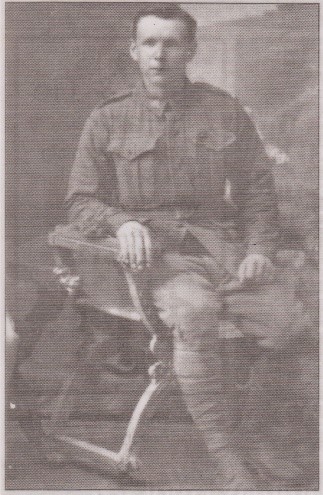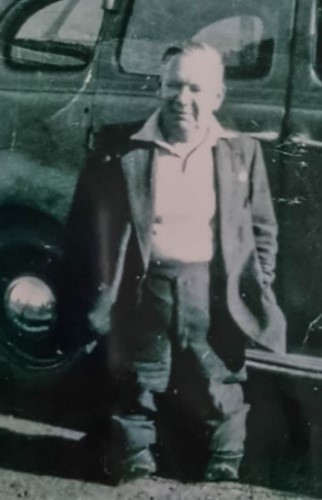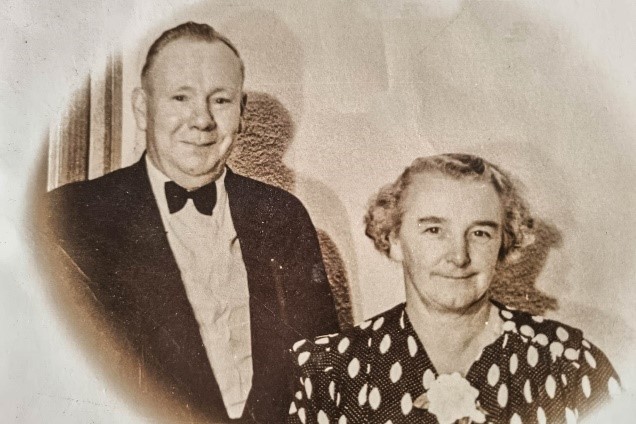Albert Prentice MM – a First World War veteran to be remembered
By Lieutenant-Colonel Lindsay Hansch, PSM (Ret)
My grandfather Albert Prentice would have been embarrassed to be called a hero, for he was a modest man. However, he was something of a legend, particularly in his adopted hometown of New Norfolk in the Derwent Valley of Tasmania. This is the story of how a humble grocer became that legend.
Early life
Albert was born in Greys, Essex, UK on 7 August 1891. He came to Australia after the death of his mother in 1912 to join his uncle, Tom Andrews.
Uncle Tom could not immediately provide him with employment so Albert was forced to look elsewhere. His search for work took him to Queenstown on the remote west coast of Tasmania. There, he found a job working on a construction gang building a pipeline between Lake Margaret and Queenstown. Later, he worked in a grocery store.
Going to war
Albert enlisted in the Australian Imperial Force (AIF) on 14 April 1915, only 11 days before the Allied landing on the Gallipoli Peninsula. He was added to the posted strength of 26th Battalion and on 20 June that year, only nine weeks after enlistment, sailed for Gallipoli.
Little is recorded of Albert’s time at Gallipoli until, in October that year, he contracted enteric fever (typhoid). He was hospitalised at Gallipoli, then evacuated to Malta, then to Egypt. A medical review of his condition in Cairo in early January 1916 recommended three months convalescent leave, so he was evacuated to Australia.

He returned to duty at the end of March 1916 and on 8 August he embarked for England where he joined the 3rd Training Battalion.
After initial training in Western Front warfare, he was cleared for combat duty. So, on 20 November he was transferred to 1 Australian Division Base Depot and from there was added to the posted strength of 12th Battalion. Shortly afterwards, he found himself in the front line at Kogge (near Ypres) in Belgium.
Albert quickly learned about trench warfare and survival, experiencing frequent German artillery bombardment, including the occasional gas shell.
He was promoted to lance-corporal in April 1917 and to corporal in July. On the night of 19 September, he received a shrapnel wound to his right shoulder. The wound was not serious and he returned to the line a few days later.
The end of his war
In late September his unit had been pulled back for a brief rest. When they were ordered back to the front line on 1 October, Albert was acting platoon sergeant. During the move forward, his platoon commander was killed. Corporal Albert Prentice stepped up and took command, guiding his platoon into position and taking over his allotted portion of the front line.
On 6 October Albert’s platoon position was subjected to a particularly heavy German artillery bombardment. The battalion war diary noted that ‘by his great coolness and courage, Corporal Prentice kept his men in cheerful spirits’.
The following day they were again subjected to a heavy German bombardment. During this, Albert’s trench took a direct hit from a shell, killing every man except Albert. He happened to be sitting facing in the direction from which the shell came and it virtually landed at his feet. The explosion threw him up onto the parapet behind the trench, shattering both his legs. In trying to protect his head with his arm, he lost part of a finger and suffered a shrapnel wound to his forehead.
When Albert recovered his senses, he realised he was alone. He also realised that if he did not take action quickly, he would bleed to death. One of his legs was so badly damaged that he self-amputated it below the knee with his pocket knife. He then applied tourniquets to both legs.
At about that time Roy Pinner appeared on the scene. Roy was, coincidentally, another Tasmanian but from a different unit. He was employed as a runner, carrying messages between units and headquarters. Roy carried the badly wounded digger to the Regimental Aid Post and in doing so probably saved his life.
[It is interesting to note that Roy was unaware that the man he carried from the battlefield that day had survived until, in 1948, he received a letter from Albert asking if he was the Roy Pinner who had saved his life at Ypres. Sadly, however, the two never got to meet as Albert passed away later that same year.]
After initial stabilisation, Albert was evacuated to a field hospital and then, on 12 November, to England where he was admitted to Queen Alexandra Memorial Hospital at Millbank. There, doctors concluded that his other leg could not be saved and it was amputated, also below the knee.
Albert was later awarded the Military Medal for his leadership and courage.
Rebuilding his life
What followed for Albert was a long period of rehabilitation and convalescence. He was fitted with artificial legs but found it difficult to walk on them. One thigh had been so badly lacerated by shrapnel that he lacked the strength to lift the leg enough to walk properly. However, he persisted in the hope of regaining sufficient strength to get by.
It was during his rehabilitation that he met Emma Caroline Hill (always known as Carrie). Carrie was a nurse’s aide at Millbank. Their relationship blossomed and when Albert was finally able to return to Australia in mid-1919, he brought with him a wife.
His military records show that they disembarked in Melbourne on 1 August 1919. They later travelled on to Tasmania.
But wearing artificial legs continued to be a problem for him. Eventually he abandoned them and resorted to walking on his knees. He approached a local bootmaker and had him make a pair of knee boots. These provided him with his day-to-day mobility and served him well for the remainder of his life. He did occasionally use a wheelchair for longer distances.
Albert was discharged from the army on 15 October 1919, and he and Carrie set up home and bought a grocery store at the top end of High Street in New Norfolk. They went on to have seven children, although, sadly, they lost their eldest daughter, Mary, to the Spanish flu at the age of two months.
The store, however, was not a success. During the post-war years, money was scarce and many people could not afford to pay for daily needs. Some would run up bills that they were simply unable to pay and there was little a storekeeper was able to do about it other than to refuse credit. Also, Carrie was known to give struggling people food rather than see them go hungry. So, eventually they were forced to close the shop.
Being unable to obtain work due to his disabilities, Albert was thereafter forced to survive and maintain his growing family on his TPI pension.

Making the best of life
His disabilities did not keep Albert from living life to the fullest. He was keen on fishing, made his own rods and was an active member of the New Norfolk Anglers Club. He could be found regularly at one of the local fishing spots, often with a group of kids in tow.
Albert owned a car that was modified with a hand throttle. It also had leggings attached to the brake and clutch that he could strap onto his stumps and thereby operate the pedals. He also, for a time, owned a motorcycle with a sidecar. He had the bike modified so that he could operate it while sitting in the sidecar. If Carrie went with him on one of his excursions she sat on the bike. The sight of them riding around New Norfolk would no doubt have been the source of considerable amusement to the locals.
Albert was elected to the New Norfolk Council in the 1930s.
Immediately after his return to Australia, Albert became actively involved in the RSL. He was a member of the New Norfolk Sub-branch and served in various capacities. He was elected president in 1946 and 1947. During his tenure as president the plans for the clubrooms were drawn up and approved. Unfortunately, he did not live to see them come to fruition.
During and immediately after the Second World War, Albert was a strong advocate for the diggers returning from that war. He fought for their entitlements and helped them return to civilian life. He understood the impact of war on those who served and many ex-diggers from the Derwent Valley appreciated and valued his support and, indeed, that of his fellow RSL members.
Carrie was also a great supporter of the RSL through her service in the Ladies Guild. She served as president of the New Norfolk Sub-Branch Ladies Guild for 27 years and was awarded a Certificate of Merit by the RSL for her service.

Despite his disabilities, Albert was keen on sport. He loved playing billiards and snooker and could often be found around the tables at the men’s club attached to the library. He supported the RSL football team, mainly as goal umpire but was also known to take the field when there was a need.
His best-known sporting achievements, however, were on the cricket field. He played as a wicket keeper and his agility behind the stumps, even in middle age, was described by those who knew him, as astounding. He was, apparently, no slouch with the bat either. Well-known local Ken O’Brien describes an occasion when he and Albert were playing together.
‘I was at the non-striker’s end when Albert came in to bat, striding out on his knee pads, grit and determination written all over his face. “How do I bowl to him?” asked the bowler. “Underarm?”. I said, “Just bowl as usual,” which he did and Albert cracked the ball for four.’
Vale
Albert Prentice MM, disabled veteran, dedicated family man and certainly a local legend, died in 1948, aged 57. The cause of Albert’s death was officially cancer but I believe that the effects of the war were a major contributing factor.
Sadly, he did not live long enough to get to know his grandchildren but we all know about him and he will live forever in our memories. We Will Remember Him.
Lieutenant Colonel Lindsay Hansch PSM (Ret) was born in New Norfolk, Tasmania in 1946. He served in the Army for 27 years, initially as a soldier and then as an infantry and special forces officer, including two tours of duty in South Vietnam as well as postings in Singapore and the United States. He was a public servant for 15 years and was awarded the Public Service Medal in 2001 for his contributions to counter-terrorism and security for the Sydney 2000 Olympic Games. He retired in 2006.
